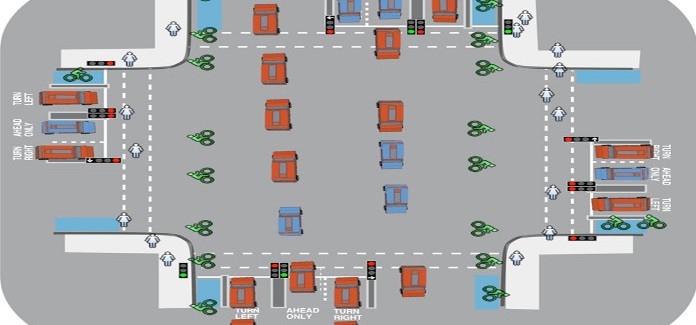Rik Andrew was invited to lead a discussion of cycling infrastructure at the meeting on Jan 14th 2015. Favourite quotes: “One major hazard on a route will deter 98% of potential users”; Regarding the proposed Central Grid, “..had got going – slowly”
3 useful documents were circulated and are attached here, just click the links:
- How to make space for cycling How_to-make_space
- Cycle route quality criteria Cycle Route Quality Criteria
- New Mode Filters in Southwark New Mode Filters in Southwark_only
The draft summary prepared for the minutes of that meeting is given below.
Rik spoke for 75 packed minutes on road design for cycling. He gave us context specific advice for cycling in Southwark and access to his knowledge of cycling design in other European countries. Specifically he said that Southwark could be the cycling equivalent of Hackney. It had a similar topography (a lot of it was flat) and a similar level of car ownership combined with good public transport links. Targets should be 10% of journeys by 2020 and once this critical mass was achieved 50% should be possible.
Route planning: one major hazard was enough to deter most people. Routes had to be safe and good quality end-to-end. Group should consider whether proposed investment in Spine might be better spent on improving LCN 22 and 23.
He said Greenways should be wide with good sightlines, well signed. Access was the problem, probably daylight only. Blind corners, poor surface, lack of width were the problems.
Minor road routes (LCNs): needed to be 20mph, traffic-calmed, traffic-excluded or very lightly used. They needed safe junctions and good lighting. Problems: unsafe junctions, no main road crossing, over-parked, indirect. Unsuitable: rat runs and one-way streets — traffic too fast and often on wrong side of the road.
Major routes (traffic distributors): cyclists could be physically segregated, with wide mandatory 24 hr protection, no parking/loading, modified junctions. Unsuitable: advisory lanes, obstructed, narrow, part time, serious hazards.
On these distributor roads he gave examples of making space for cycling: remove central reservation on Jamaica Road; replace islands with zebra crossings on Peckham Rye; no chicanes without cycle bypasses; banning right turns into and out of side roads.
Parking loading, one side only or alternating am/pm; parking moved into side roads, narrow pavement in cases of low ped flow; floating bus stops (low use only)
Discussion of junctions he suggested regularising the number of access and exit lanes at junctions, and restricting lane changes. Traffic jockeying for position at junctions was a major hazard. Space released could be used for protected space for cyclists.
Two-way cycle tracks take less space than two one-way tracks and provide greater capacity at peak hours (ie for commuting).
Rik wasn’t keen on contraflows saying that they were frequently obstructed; peds and drivers didn’t realise need to look both ways (sign problem). Contraflows OK for few, slow vehicles. Not Bermondsey Street which had a lot of fast rat-running traffic in the middle of the road. Mode filters (bollards in the middle of the road) didn’t reduce residential parking but needed space to turn.
He wasn’t keen on ASLs which, he said, were no use when lights were green or early lights for cyclists to allow them to start across junctions before the main motorised traffic. He felt this was only useful for 1-2 cyclists leaving the remainder to be squashed by the traffic. He suggested roads suitable for filtered permeability (action list for cycling strategy) and answered questions.


Submit a Comment